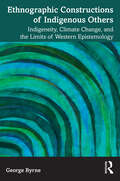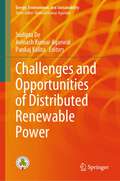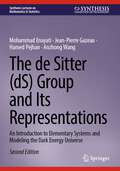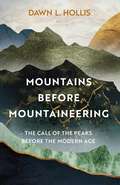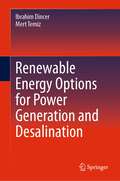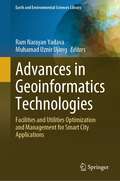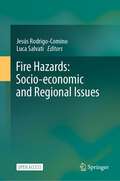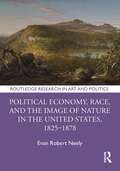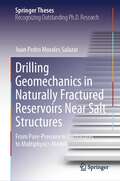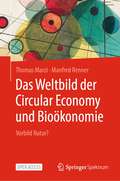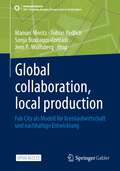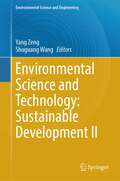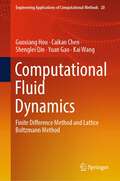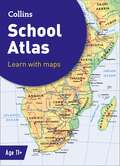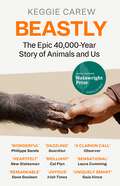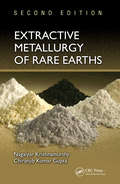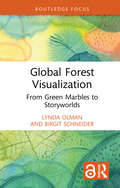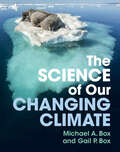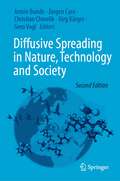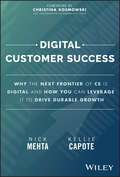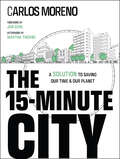- Table View
- List View
Ethnographic Constructions of Indigenous Others: Indigeneity, Climate Change, and the Limits of Western Epistemology
by George ByrneThis book examines the ways in which indigeneity interacts with climate change politics at multiple levels and at the same time offers a self-critical reflection on the role of ethnographic research (and researchers) in this process. Through a multi-sited ethnography, it shows how indigeneity and climate change mitigation are at this point so intensely intertwined that one cannot be clearly understood without considering the other. While indigenous identities have been (re)defined in relation to climate change, it argues that Indigenous Peoples continue to subvert pervasive notions of the nature/culture dichotomy and disrupt our understanding of what it means to be human in relation to nature. It encourages students and researchers in anthropology, international development, and other related fields to engage in more meaningful reflection on the epistemic shortcomings of “the West”, including in our own research, and to acknowledge the ongoing role of power, coloniality, extractivism, and whiteness in climate change discourses.
Ethnographic Constructions of Indigenous Others: Indigeneity, Climate Change, and the Limits of Western Epistemology
by George ByrneThis book examines the ways in which indigeneity interacts with climate change politics at multiple levels and at the same time offers a self-critical reflection on the role of ethnographic research (and researchers) in this process. Through a multi-sited ethnography, it shows how indigeneity and climate change mitigation are at this point so intensely intertwined that one cannot be clearly understood without considering the other. While indigenous identities have been (re)defined in relation to climate change, it argues that Indigenous Peoples continue to subvert pervasive notions of the nature/culture dichotomy and disrupt our understanding of what it means to be human in relation to nature. It encourages students and researchers in anthropology, international development, and other related fields to engage in more meaningful reflection on the epistemic shortcomings of “the West”, including in our own research, and to acknowledge the ongoing role of power, coloniality, extractivism, and whiteness in climate change discourses.
Challenges and Opportunities of Distributed Renewable Power (Energy, Environment, and Sustainability)
by Sudipta De Avinash Kumar Agarwal Pankaj KalitaDue to limited non-renewable resources and climate change problems, the global energy sector must be transformed from fossil fuel dominated to renewable energy based. However, due to constraints of resources, technology, locked capital in existing energy systems, limited financial support, and associated risks in investment, etc., this transformation is not expected to occur rapidly. Rather there should be an energy transition path with planned replacement of fossil fuel-based systems to renewable-based ones. Large-scale renewable power is yet to be dominant globally. Distributed renewable power is appearing to be more common as its implementation requires smaller investments with lesser financial risks. There are several options of such distributed renewable power with great prospects at different locations. Simultaneously, there are many challenges to overcome for successful implementation of such projects. These challenges are also multi-dimensional. In this book, several chapters address bright prospects of several options of distributed renewable power. Simultaneously, other chapters address challenges of implementation of such technologies. The chapters together cover a wide perspective of both prospects and associated challenges to be addressed for it. Chapters include technological issues, optimization of energy systems, logistics and policies, case studies etc. Researchers, industry professionals, and students can benefit from this book.
The de Sitter: An Introduction to Elementary Systems and Modeling the Dark Energy Universe (Synthesis Lectures on Mathematics & Statistics)
by Mohammad Enayati Jean-Pierre Gazeau Hamed Pejhan Anzhong WangThis Second Edition is a comprehensive update, integrating the latest research and theoretical advancements in the field of de Sitter (dS) group representations. Building on the success of the first edition, the book offers a more in-depth analysis of mathematical aspects, conceptual foundations, and practical implications related to the dS group, including its Lie manifold, Lie algebra, and co-adjoint orbits, viewing the latter as potential classical elementary systems within the context of dS spacetime. Additionally, the examination of unitary irreducible representations (UIRs) sheds light on the potential existence of quantum elementary systems within the dS spacetime framework. The authors emphasize consistency with Wigner's approach to elementary systems, incorporate Wigner's principles and exploring projective UIRs of the dS group, and provide a deeper insight into the nature of dS elementary systems. Particular attention is paid to: the “smooth” transition from classical to quantum theory, the physical content under vanishing curvature, and the thermal interpretation from a quantum perspective. The book also focuses on the physical interpretation of elementary systems in curved spacetimes, recognizing the limitations of traditional concepts derived from flat Minkowski spacetime and the Poincaré group.
Renewable Energy Options for Power Generation and Desalination
by Ibrahim Dincer Mert TemizThis book examines simultaneous power generation and desalination driven by renewable energy systems. It covers all renewables, including solar, wind, geothermal, hydro, ocean and biomass as well as waste sources. This book also includes thermodynamic fundamentals, concepts, and system design, analysis and assessment studies, along with illustrative examples and case studies, for sustainable applications. It further provides an ample opportunity to learn more about cutting-edge technologies and newly developed systems for power generation and desalination.
Advances in Geoinformatics Technologies: Facilities and Utilities Optimization and Management for Smart City Applications (Earth and Environmental Sciences Library)
by Ram Narayan Yadava Muhamad Uznir UjangThere are many GIS products for smart cities to implement smart city projects or activities. Most of the Geoinformatics Technologies and its application books are theoretical and lack of examples with real world data and step by step explanations to understand the facilities and utilities optimization and management for smart city applications and socio-economic aspects.This book focuses and discusses topics related to how technological advances in Geoinformatics can help in the management operations of smart city applications to help our environment to be smart. Specifically, the volume focuses on how these advancements can help optimize and manage facilities and utilities. This book focuses on geoinformation modelling, geo-smart city applications, geoinformation technology, information system and computer science, and geolocation and positioning as its five primary areas of discussion. Each of these primary subjects delves into the application that uses geoinformatics technology in greater depth. This covers the use of Geoinformatics technology in the prevention of crime, coastal erosion, carbon emission modelling, landslide modelling, urban farming, and various other applications linked to the field. This book's objective is to provide a comprehensive review of the accomplishments that geoinformatics has made in a number of different application areas for smart cities. It covers Geoinformation Technologies, Geoinformation Modelling, Information System and Computer Science, Geolocation & Positioning, and Geo-Smart City Applications.The book will be useful to graduate students, university faculty, and researchers in Geoinformatics sciences/engineering and architecture and town planning. It will also be useful to entrepreneurs, professionals, and planners in policy and decision making at the local, state and national levels.
Fire Hazards: Socio-economic and Regional Issues
by Jesús Rodrigo-Comino Luca SalvatiThe open access book aims to show the readers novel, relevant and reproducible power of synergistic collaborations between European research groups and stakeholders with the objective to synthesize the existing knowledge and expertise about fire management and hazard and defining a concerted research agenda that promotes an integrated approach to create fire-resilient landscapes, taking into account biological, biochemical and physical, but also socio-economic, historical, geographical, sociological, perception and policy constraints. This is an urgent societal need due to the expected further intensification and geographical spreading of wildfire regimes under Global Change. Fire has been part of the Earth's System for the last 400 million years, and humans are the sole species that controls and manages fire. We have used fire for over a million years, both, as hunter-gatherers managing the landscape with fire and as farmers using fire as a low-cost, efficient and ecological tool for clearing and maintaining the productivity of the land. Fire has been highlighted as the most influential element in the development of human societies. The increase in prolonged dry and hot periods observed in many regions of the world is exacerbating the risk of fire. The causes of increased fire risk are not only linked to climate change but are also a consequence of economic and social changes and political decisions. Over the past few decades, many countries’ rural areas have seen significant depopulation and a reduction in land management as residents moved to cities or even other countries in search of work. The resulting rural depopulation has led to revegetation of the abandoned agricultural land, which favors fire spread. The enhanced risk of fires is moving beyond the capacity of even the best-funded wildland firefighting teams and therefore calls for the development of new approaches to fire management that are key nowadays at different scales. Instead of focusing primarily on increasing firefighting capabilities, a more effective approach is needed that focuses on long-term fire prevention through vegetation management by reducing fuel load or managing fuel type and fuel continuity at a landscape level. FIRElinks (COST Action CA18135) is developing the EU-spanning network of scientists and practitioners involved in forest fire research and land management with backgrounds such as fire dynamics, fire risk management, fire effects on vegetation, fauna, soil and water and socio-economic, historical, geographical, political perception and land management approaches. Among the different Working Groups, number 5 is aimed to connect communities from different scientific and geographic backgrounds, allowing the discussion of different experiences and the emergence of new approaches to fire research, human management, regional issues and socio-economic aspects.
Political Economy, Race, and the Image of Nature in the United States, 1825–1878 (Routledge Research in Art and Politics)
by Evan Robert NeelyPolitical Economy, Race, and the Image of Nature in the United States, 1825–1878 is an interdisciplinary work analyzing the historical origins of a dominant concept of Nature in the culture of the United States during the period of its expansion across the continent.Chapters analyze the ways in which “Nature” became a discursive site where theories of race and belonging, adaptation and environment, and the uses of literary and pictorial representation were being renegotiated, forming the basis for an ideal of the human and the nonhuman world that is still with us. Through an interdisciplinary approach involving the fields of visual culture, political economy, histories of racial identity, and ecocritical studies, the book examines the work of seminal figures in a variety of literary and artistic disciplines and puts the visual culture of the United States at the center of intellectual trends that have enormous implications for contemporary cultural practice.The book will be of interest to scholars working in art history, visual culture, American studies, environmental studies/ecocriticism, critical race theory, and semiotics.
Political Economy, Race, and the Image of Nature in the United States, 1825–1878 (Routledge Research in Art and Politics)
by Evan Robert NeelyPolitical Economy, Race, and the Image of Nature in the United States, 1825–1878 is an interdisciplinary work analyzing the historical origins of a dominant concept of Nature in the culture of the United States during the period of its expansion across the continent.Chapters analyze the ways in which “Nature” became a discursive site where theories of race and belonging, adaptation and environment, and the uses of literary and pictorial representation were being renegotiated, forming the basis for an ideal of the human and the nonhuman world that is still with us. Through an interdisciplinary approach involving the fields of visual culture, political economy, histories of racial identity, and ecocritical studies, the book examines the work of seminal figures in a variety of literary and artistic disciplines and puts the visual culture of the United States at the center of intellectual trends that have enormous implications for contemporary cultural practice.The book will be of interest to scholars working in art history, visual culture, American studies, environmental studies/ecocriticism, critical race theory, and semiotics.
Drilling Geomechanics in Naturally Fractured Reservoirs Near Salt Structures: From Pore-Pressure in Carbonates to Multiphysics Models (Springer Theses)
by Juan Pedro Morales SalazarThis book explains different phenomena that occur in Naturally Fractured Reservoirs (NFRs) of carbonate rocks neighboring a salt structure and how it affects well drilling. Prediction of carbonate pore pressure is difficult; therefore, a new set of pore pressure equations for carbonates were developed, accounting for overpressure and depleted conditions. A detailed description of a fully coupled model is shown in order to discuss geomechanics and the coupling of fluid flow in porous media and to achieve a better representation of the mechanics involved in the exploitation of NFRs. Additionally, results of a new model of geomechanics in vuggy carbonate reservoirs are presented. This book also displays a wide discussion, analysis, and numerical implementation of six different salt rheology models. Furthermore, the most representative rheology salt models were studied aside with the fully coupled model of geomechanics and fluid flow in porous media. Finally, it presents an answer to areal case of a well drilled near a salt diapir where anomalous pore pressure was found.
Das Weltbild der Circular Economy und Bioökonomie: Vorbild Natur?
by Thomas Marzi Manfred RennerDies ist ein Open-Access-Buch. Bei der Suche nach neuen Wirtschaftsformen richten sich viele Hoffnungen auf die Circular Economy und Bioökonomie. Beiden wird das Potenzial zugesprochen, die Natur mit ihren Ressourcen zu schützen und gleichzeitig wirtschaftliches Wachstum zu ermöglichen. Welche Vorstellungen aber wirken in ihrem Hintergrund? Bei beiden Konzepten spielen die „Kreisläufe der Natur“ eine wesentliche Rolle. In manchen Denkschulen der Circular Economy sind sie ein Vorbild, nach dem Wirtschaftsprozesse gestaltet werden sollen. In der Bioökonomie sind sie „die“ Grundlage des Wirtschaftens. Dieses „Weltbild der Circular Economy und Bioökonomie“ ist Thema des vorliegenden Buches.
Towards Healthy Settlements: Health Implications of Residential Suburbanization in Guangzhou (Urban Sustainability)
by Tianyao ZhangThis book aims to formulate recommendations for achieving a healthy neighborhood living environment for the middle-income people in China‘s suburbs. In China, the expeditious urbanization triggers the prosperous commodity housing development, which further grows with the spatial restructuring and socioeconomic transition. Residential suburbanization is generated, accompanied with the emergence of new-middle class and the change of lifestyle. However, the health effects of suburbanization in China are overlooked. This book investigates the health performance of suburban residents and the effects of suburban living on residents‘ health. This book also examines the resident-environment transaction modes to unfold the underlying mechanism of suburban living affecting residents’ health. Suburban residents had to passively adapt to their residential environment, which is the obstacle for achieving a health-promoting environment. The institutional dynamics determining the health performance of suburban living environment were addressed with the roles of governments, developers, planners, housing managers, residents‘ committee, and ordinary residents in commodity housing development. The book found no institutional support for the creation of health-promoting environments, especially with default of governments and excessive dependence on developers for public service facilities and the absence of civil society. Thus, the book proposes that institutional innovations are necessary in term of embedding the health dimension in all sectors of the society, enlisting collaboration between public and private sectors, and between health and non-health sectors, and thus cultivating the optimization of residents-environment transactions to create health-promoting environments.
Global collaboration, local production: Fab City als Modell für Kreislaufwirtschaft und nachhaltige Entwicklung (SDG - Forschung, Konzepte, Lösungsansätze zur Nachhaltigkeit)
by Manuel Moritz Tobias Redlich Sonja Buxbaum-Conradi Jens P. WulfsbergDieses Open-Access-Buch gibt aktuelle interdisziplinäre Forschungseinblicke rund um das Fab City-Konzept. Ein Ansatz, der beschreibt, wie Produktions- und Konsumptionsweisen gestaltet werden können, sodass einerseits globale Kollaboration in und durch Communities von der Ideengenerierung bis zur Produktentwicklung physischer Güter mittels quelloffener Technologien (Open Source Software und Hardware) ermöglicht wird und andererseits die Produktion dieser Güter lokal und somit möglichst nahe am Ort des Bedarfs sowie dezentral im Sinne einer verteilten Produktion erfolgen kann, beispielsweise in Fab(rication) Labs. Ziel ist die Schaffung einer möglichst nachhaltigen Produktion bzw. Wertschöpfung. Ökologisch nachhaltig, indem lange Transportwege vermieden und auf Grundlage von Kreislaufprinzipien lokale Stoffkreisläufe geschlossen werden. Ökonomisch nachhaltig, indem durch quelloffene Technologien Wettbewerbsbeschränkungen und durch föderierte Ansätze Abhängigkeiten vermieden werden. Sozial nachhaltig durch ein partizipatives Wertschöpfungssystem, in dem der Zugang zu Wissen und Knowhow sowie zu Produktionsmitteln unbeschränkt ist. Über den gesamten Produktentstehungsprozess und -lebenszyklus enthält das vorliegende, bilinguale Werk in deutscher und englischer Sprache Beiträge aus den Bereichen Citizen & Collaborative Innovation and Design, Circular Design & Economy, Open-Source-Software-Tools für die Entwicklung von Open Source Hardware, Digital Product Passport, föderierte (Open-Source-) Systeme, die Verbreitung von Open Source Hardware sowie technical literacy und economic governance.Prof. Neil Gershenfeld, Director of MIT’s Center for Bits and Atoms, and Chairman of the board of The Fab Foundation:“For many years the growth of cities has been an inexorable trend, with cities acting as regional magnets and engines;the resources enabling a Fab City can also help expand opportunity beyond cities. There is now an opportunity and need for labs that can develop, deploy, and measure the frontiers of Fab City technologies. This book provides a much-needed snapshot of the current state of that challenge.”Tomas Diez, Executive Director of the Fab City Foundation: “This book is an invitation for large-scale collaboration to build distributed system that can support the development of alternative modes of production, in line with the social and ecological needs of our time.”
Environmental Science and Technology: Sustainable Development II (Environmental Science and Engineering)
by Yang Zeng Shuguang WangThis book features a collection of high-quality and peer-reviewed papers from 2023 14th International Conference on Environmental Science and Technology, which was held in Shandong, China, during November 23–25, 2023. ICEST is held annually as a platform for presentation of new advances and research results in the fields of Environmental Science and Technology. With the continuous development of human society, environmental problems are becoming more and more serious. Recently, we face some difficult problems such as: global climate change, ozone layer destruction and depletion, acid rain pollution, desertification, and water resources crisis. Based on the theme this year, the presentations include the topical areas of environmental sustainability, waste minimization, solid waste management, water pollution control, water treatment and reclamation, air pollution control, carbon capture and storage and environmental monitoring, etc.
Computational Fluid Dynamics: Finite Difference Method and Lattice Boltzmann Method (Engineering Applications of Computational Methods #20)
by Guoxiang Hou Caikan Chen Shenglei Qin Yuan Gao Kai WangThis book provides a concise and comprehensive introduction to several basic methods with more attention to their theoretical basis and applications in fluid dynamics. Furthermore, some new ideas are presented in this book, for example, a method to solve the transition matrix by difference operator transformation. For this method, the book gives the definition of Fourier integral transformation of translation operator, and proves the transition matrix equaling to the differential operator transformation, so that it is extended to general situations of explicit, implicit, multi-layer difference equations, etc. This flexible approach is also used in the differential part. In addition, the book also includes six types of equivalent stability definitions in two ways and deeply analyzes their errors, stabilities and convergences of the difference equations. What is more important, some new scientific contributions on lattice Boltzmann method (LBM) in recent years are presented in the book as well. The authors write the book combining their ten years teaching experience and research results and this book is intended for graduate students who are interested in the area of computational fluid dynamics (CFD). Authors list some new research achievements, such as simplified lattice Boltzmann method, the simplified lattice Boltzmann flux solver and discrete unified gas kinetic scheme, and expect that this new information could give readers possible further investigating ideas in their future research on CFD area.
Collins School Atlas: Ideal For Learning At School And At Home (Collins School Atlas Ser. #6)
by Collins MapsBeastly: A New History of Animals and Us
by Keggie CarewSHORTLISTED FOR THE WAINWRIGHT PRIZE FOR CONSERVATION A BOOK OF THE YEAR FOR THE FINANCIAL TIMES, WATERSTONES AND BBC HISTORY MAGAZINE A NEXT BIG IDEA CLUB MUST READ Beastly is the 40,000-year story of our changing kinship with the animal world - from the smallest microbe to the largest creature that ever lived. Exploring this relationship through history, culture, science and inspiring examples, Carew makes the passionate case that animals are the key to the planet's future health, but only if we can save them.
Extractive Metallurgy of Rare Earths
by Nagaiyar Krishnamurthy Chiranjib Kumar GuptaNew Edition Now Covers Recycling, Environmental Issues, and Analytical DeterminationEmploying four decades of experience in the rare metal and rare earths industry, the authors of Extractive Metallurgy of Rare Earths, Second Edition present the entire subject of rare earth elements with depth and accuracy. This second edition updates the most impor
Global Forest Visualization: From Green Marbles to Storyworlds (Routledge Focus on Environment and Sustainability)
by Lynda Olman Birgit SchneiderThis book project examines global forest monitoring as a means to understand the promises and problems of global visualization for climate management.Specifically, the book focuses on Global Forest Watch, the most developed and widely available forest-monitoring platform, created in 1997 by the World Resource Institute. Forest maps are always political as they visualize power relations and form the grid within which forests become commodities. This dislocation of the idea of the forest from its literal roots in the ground has generated problems for forest visualization efforts designed to empower local communities. This book takes a critical humanistic approach to this problem, combining methods from the fields of rhetoric and media studies to suggest solutions to these problems for designers and users of platforms like the Global Forest Watch. To explain why global views of forests can be disempowering, the book relies on biopolitical and rhetorical theories of panopticism and how these views unfold a different violence on different regions of the Earth in relation to colonial history. Using this theoretical framework, the book explains the historical process by which forests came to be classified, quantified, and mapped on a global scale. Interviews with end-users of global forest visualization platforms reveal if and how these platforms support local action. Lastly, the book provides rhetorical solutions to articulate global and local views of forests without reducing one view to the other. These solutions involve looking to forests themselves for clues about how to generate more broadly effective and resilient visualizations.This book will be of great interest to students and scholars of forest studies, climate change, science communication, visualization studies, environmental communication, and environmental conservation.The Open Access version of this book, available at http://www.taylorfrancis.com, has been made available under a Creative Commons [Attribution-Non Commercial-No Derivatives (CC-BY-NC-ND)] 4.0 license.
The Science of Our Changing Climate
by null Michael A. Box null Gail P. BoxThis compelling textbook provides a broad overview of the science underpinning our understanding of our climate, and how it is changing. Presented in clear and accessible language, and requiring only minimal algebra, it enables students to understand how our planet “behaves” under “normal conditions” and how human activity has moved us away from that normal. It walks the student comprehensively through the basic science, including how greenhouse gases absorb radiation and, crucially, a chapter on aerosols, major players in climate change. Diverse case studies and examples illuminate the impact and connections to real world events while review questions and exercises consolidate knowledge. Including the latest results from the IPCC 6th Assessment Report, it concludes by exploring climate modelling, equipping students with an understanding of how to simulate both past climate changes and projections of future climate change. Online resources include lecture slides, solutions and Excel code.
Diffusive Spreading in Nature, Technology and Society
by Armin Bunde Jürgen Caro Christian Chmelik Jörg Kärger Gero VoglWhat do the movements of molecules and the migration of humans have in common? How does the functionality of our brain tissue resemble the flow of traffic in New York City? How can understanding the spread of ideas, rumors, and languages help us tackle the spread a pandemic? This book provides an illuminating look into these seemingly disparate topics by exploring and expertly communicating the fundamental laws that govern the spreading and diffusion of objects. A collection of leading scientists in disciplines as diverse as epidemiology, linguistics, mathematics, and physics discuss various spreading phenomena relevant to their own fields, revealing astonishing similarities and correlations between the objects of study—be they people, particles, or pandemics. This updated and expanded second edition of an award-winning book introduces timely coverage of a subject with the greatest societal impact in recent memory—the global fight against COVID-19. Winner of the 2019Literature Prize of the German Chemical Industry Fund and brainchild of the international and long-running Diffusion Fundamentals conference series, this book targets an interdisciplinary readership, featuring an introductory chapter that sets the stage for the topics discussed throughout. Each chapter provides ample opportunity to whet the appetite of those readers seeking a more in-depth treatment, making the book also useful as supplementary reading in appropriate courses dealing with complex systems, mass transfer, and network theory. Chapter “Neolithic Transitions: Diffusion of People or Diffusion of Culture?” is available open access under a Creative Commons Attribution 4.0 International License via link.springer.com.
Digital Customer Success: Why the Next Frontier of CS is Digital and How You Can Leverage it to Drive Durable Growth
by Nick Mehta Kellie CapoteAutomate your Customer Success efforts to reduce churn and increase profits In Digital Customer Success: The Next Frontier, a team of trailblazing Customer Success professionals and digital entrepreneurs delivers an insightful discussion of the next stage in Customer Success management. In the book, you'll discover how to design and deploy touchless and automated digital interventions that help your software users learn and grow as they use your product and unlock the value trapped within it — without ever needing to reach out to a live Customer Success Manager. The authors provide a detailed “How-To” guide to Digital Customer Success that explains how you can meet the needs of your customers, investors, and team members. You'll explore the basics of the authors' original Digital Customer Success Maturity Model and the core tenets of how to get started. After that, you'll find: Explanations of the ideal organizational structures to enable Digital Customer Success management Case studies and examples from real companies blazing new trails in Customer Success Critical success measurements and metrics you can use to determine if your company is on the right track or if it needs to reorient Perfect for managers, executives, directors, founders, entrepreneurs, and other business leaders involved in the sale of digital and software products, Digital Customer Success is also a can't-miss resource for Customer Success professionals, sales leaders, marketers, product development professionals, and anyone else with a stake in reducing customer churn and increasing revenues.
Digital Customer Success: Why the Next Frontier of CS is Digital and How You Can Leverage it to Drive Durable Growth
by Nick Mehta Kellie CapoteAutomate your Customer Success efforts to reduce churn and increase profits In Digital Customer Success: The Next Frontier, a team of trailblazing Customer Success professionals and digital entrepreneurs delivers an insightful discussion of the next stage in Customer Success management. In the book, you'll discover how to design and deploy touchless and automated digital interventions that help your software users learn and grow as they use your product and unlock the value trapped within it — without ever needing to reach out to a live Customer Success Manager. The authors provide a detailed “How-To” guide to Digital Customer Success that explains how you can meet the needs of your customers, investors, and team members. You'll explore the basics of the authors' original Digital Customer Success Maturity Model and the core tenets of how to get started. After that, you'll find: Explanations of the ideal organizational structures to enable Digital Customer Success management Case studies and examples from real companies blazing new trails in Customer Success Critical success measurements and metrics you can use to determine if your company is on the right track or if it needs to reorient Perfect for managers, executives, directors, founders, entrepreneurs, and other business leaders involved in the sale of digital and software products, Digital Customer Success is also a can't-miss resource for Customer Success professionals, sales leaders, marketers, product development professionals, and anyone else with a stake in reducing customer churn and increasing revenues.
The 15-Minute City: A Solution to Saving Our Time and Our Planet
by Carlos MorenoA fresh and innovative perspective on urban issues and creating sustainable cities In The 15-Minute City: A Solution for Saving Our Time and Our Planet, human city pioneer and international scientific advisor Carlos Moreno delivers an exciting and insightful discussion of the deceptively simple and revolutionary idea that everyday destinations like schools, stores, and offices should only be a short walk or bike ride away from home. This book tells the story of an idea that spread from city to city, describing a new way of looking at living that addresses many of the most intractable challenges of our time. Hundreds of mayors worldwide have already embraced the concept as a way to help recover from the pandemic, and the idea continues to gain speed. You'll learn why more and more cities are planning to make cars far less necessary for contemporary city-dwellers and how they're planning to achieve that goal. You'll also find: Strategies for cities to recover and adapt to benefit residents, saving them precious time Techniques to change the habits of automobile-dependent city residents and maximize social benefits of living in a human-centric city Scientifically developed, research-backed solutions for enduring urban issues and problems Deeply committed to science, progress, and creativity, Moreno presents an essential and timely resource in The 15-Minute City, which will prove invaluable to anyone with an interest in modern and innovative approaches to consistently challenging urban issues that have bedeviled policy makers and city residents since the invention of the car.
